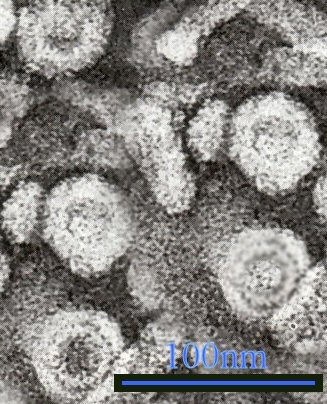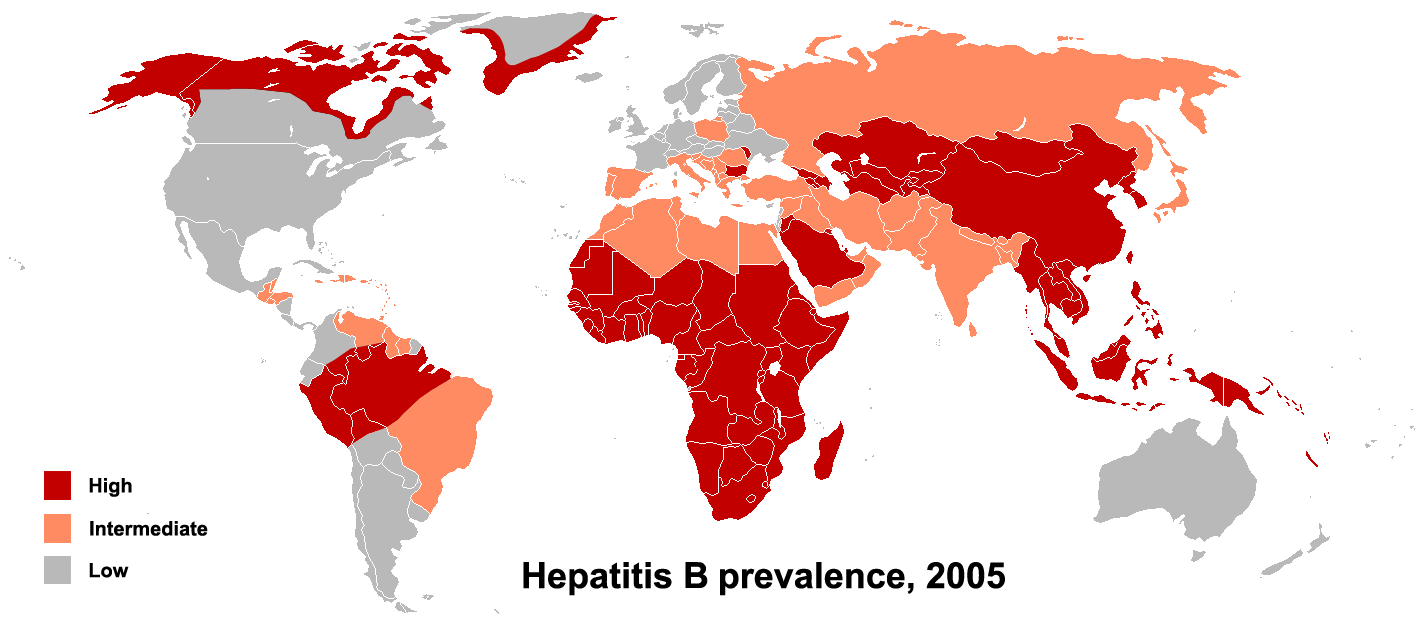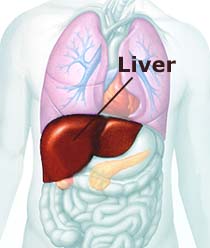Hepatitis B virus
Editor-In-Chief: C. Michael Gibson, M.S., M.D. [1]
Overview
| Hepatitis B virus | ||||||||
|---|---|---|---|---|---|---|---|---|
 Micrograph showing hepatitis B virions
| ||||||||
| Virus classification | ||||||||
|
|
WikiDoc Resources for Hepatitis B virus |
|
Articles |
|---|
|
Most recent articles on Hepatitis B virus Most cited articles on Hepatitis B virus |
|
Media |
|
Powerpoint slides on Hepatitis B virus |
|
Evidence Based Medicine |
|
Cochrane Collaboration on Hepatitis B virus |
|
Clinical Trials |
|
Ongoing Trials on Hepatitis B virus at Clinical Trials.gov Trial results on Hepatitis B virus Clinical Trials on Hepatitis B virus at Google
|
|
Guidelines / Policies / Govt |
|
US National Guidelines Clearinghouse on Hepatitis B virus NICE Guidance on Hepatitis B virus
|
|
Books |
|
News |
|
Commentary |
|
Definitions |
|
Patient Resources / Community |
|
Patient resources on Hepatitis B virus Discussion groups on Hepatitis B virus Patient Handouts on Hepatitis B virus Directions to Hospitals Treating Hepatitis B virus Risk calculators and risk factors for Hepatitis B virus
|
|
Healthcare Provider Resources |
|
Causes & Risk Factors for Hepatitis B virus |
|
Continuing Medical Education (CME) |
|
International |
|
|
|
Business |
|
Experimental / Informatics |
Hepatitis B virus infects the liver of hominoidae, including humans, and causes an inflammation called hepatitis. It is a DNA virus and one of many unrelated viruses that cause viral hepatitis. The disease was originally known as "serum hepatitis"[1]and has caused epidemics in parts of Asia and Africa. Hepatitis B is endemic in China and various other parts of Asia.[2] The proportion of the world's population currently infected with the virus is estimated at 3 to 6%, but up to a third have been exposed. Symptoms of the acute illness caused by the virus include liver inflammation, vomiting, jaundice, and rarely, death. Chronic hepatitis B may eventually cause liver cirrhosis and liver cancer, a fatal disease with very poor response to current chemotherapy.[3] The infection is preventable by vaccination.[4]
History
The earliest record of an epidemic caused by Hepatitis B virus was made by Lurman in 1885.[5] An outbreak of smallpox occurred in Bremen in 1883 and 1,289 shipyard employees were vaccinated with lymph from other people. After several weeks, and up to eight months later, 191 of the vaccinated workers became ill with jaundice and were diagnosed as suffering from serum hepatitis. Other employees who had been inoculated with different batches of lymph remained healthy. Lurman's paper, now regarded as a classical example of an epidemiological study, proved that contaminated lymph was the source of the outbreak. Later, numerous similar outbreaks were reported following the introduction, in 1909, of hypodermic needles that were used, and more importantly reused, for administering Salvarsan for the treatment of syphilis. The virus was not discovered until 1965 when Baruch Blumberg, then working at the National Institutes of Health (NIH), discovered the Australia antigen (later known to be Hepatitis B surface antigen, or HBsAg) in the blood of Australian aboriginal people.[6] Although a virus had been suspected since the research published by MacCallum in 1947.[7] In 1970, D.S. Dane and others discovered the virus particle by electron microscopy.[8] By the early 1980s the genome of the virus had been sequenced,[9] and the first vaccines were being tested.[10]
Microbiology
Structure

Hepatitis B virus (HBV) is a member of the Hepadnavirus family.[11] The virus particle, (virion) consists of an outer lipid envelope and an icosahedral nucleocapsid core composed of protein. The nucleocapsid encloses the viral DNA and a DNA polymerase that has reverse transcriptase activity.[12] The outer envelope contains embedded proteins which are involved in viral binding of, and entry into, susceptible cells. The virus is one of the smallest enveloped animal viruses with a virion diameter of 42nm, but pleomorphic forms exist, including filamentous and spherical bodies lacking a core. These particles are not infectious and are composed of the lipid and protein that forms part of the surface of the virion, which is called the surface antigen (HBsAg), and is produced in excess during the life cycle of the virus.[13]
Genome

The genome of HBV is made of circular DNA, but it is unusual because the DNA is not fully double-stranded. One end of the full length strand is linked to the viral DNA polymerase. The genome is 3020-3320 nucleotides long (for the full length strand) and 1700-2800 nucleotides long (for the short length strand).[14] The negative-sense, (non-coding), is complementary to the viral mRNA. The viral DNA is found in the nucleus soon after infection of the cell. The partially double-stranded DNA is rendered fully double-stranded by completion of the (+) sense strand and removal of a protein molecule from the (-) sense strand and a short sequence of RNA from the (+) sense strand. Non-coding bases are removed from the ends of the (-)sense strand and the ends are rejoined. There are four known genes encoded by the genome called C, X, P, and S. The core protein is coded for by gene C (HBcAg), and its start codon is preceded by an upstream in-frame AUG start codon from which the pre-core protein is produced. HBeAg is produced by proteolytic processing of the pre-core protein. The DNA polymerase is encoded by gene P. Gene S is the gene that codes for the surface antigen (HBsAg). The HBsAg gene is one long open reading frame but contains three in frame "start" (ATG) codons that divide the gene into three sections, pre-S1, pre-S2, and S. Because of the multiple start codons, polypeptides of three different sizes called large, middle, and small (pre-S1 + pre-S2 + S, pre-S2 + S, or S) are produced.[15] The function of the protein coded for by gene X is not fully understood.[16]
Replication

The life cycle of Hepatitis B virus is complex. Hepatitis B is one of a few known non-retroviral viruses which use reverse transcription as a part of its replication process. The virus gains entry into the cell by binding to a receptor on the surface of the cell and enters it by endocytosis. Because the virus multiplies via RNA made by a host enzyme, the viral genomic DNA has to be transferred to the cell nucleus by host proteins called chaperones. The partially double stranded viral DNA is then made fully double stranded and transformed into closed circular supercoiled DNA (cccDNA) that serves as a template for transcription of four viral mRNAs. The largest mRNA, (which is longer than the viral genome), is used to make the new copies of the genome and to make the capsid core protein and the viral DNA polymerase. These four viral transcripts undergo additional processing and go on to form progeny virions which are released from the cell or returned to the nucleus and re-cycled to produce even more copies.[15][17] The long mRNA is then transported back to the cytoplasm where the virion P protein synthesizes DNA via its reverse transcriptase activity.
Serotypes
The virus is divided into four major serotypes (adr, adw, ayr, ayw) based on antigenic epitopes present on its envelope proteins, and into eight genotypes (A-H) according to overall nucleotide sequence variation of the genome. The genotypes have a distinct geographical distribution and are used in tracing the evolution and transmission of the virus. Differences between genotypes affect the disease severity, course and likelihood of complications, and response to treatment and possibly vaccination.[18][19]
Transmission

Transmission results from exposure to infectious blood or body fluids containing blood. Possible forms of transmission include (but are not limited to) unprotected sexual contact, blood transfusions, re-use of contaminated needles & syringes, and vertical transmission from mother to child during childbirth. Without intervention, a mother who is positive for the hepatitis B surface antigen confers a 20% risk of passing the infection to her offspring at the time of birth. This risk is as high as 90% if the mother is also positive for the hepatitis B e antigen. HBV can be transmitted between family members within households, possibly by contact of nonintact skin or mucous membrane with secretions or saliva containing HBV.[20] However, at least 30% of reported hepatitis B among adults cannot be associated with an identifiable risk factor.[21]
The primary method of transmission reflects the prevalence of chronic HBV infection in a given area. In low prevalence areas such as the continental United States and Western Europe, where less than 2% of the population is chronically infected, injection drug abuse and unprotected sex are the primary methods, although other factors may be important.[22] In moderate prevalence areas, which include Eastern Europe, Russia, and Japan, where 2-7% of the population is chronically infected, the disease is predominantly spread among children. In high prevalence areas such as China and South East Asia, transmission during childbirth is most common, although in other areas of high endemicity such as Africa, transmission during childhood is a significant factor.[23] The prevalence of chronic HBV infection in areas of high endemicity is at least 8%.
Pathogenesis

The hepatitis B virus primarily interferes with the functions of the liver by replicating in liver cells, known as hepatocytes. During HBV infection, the host immune response causes both hepatocellular damage and viral clearance. Although the innate immune response does not play a significant role in these processes, the adaptive immune response, particularly virus-specific cytotoxic T lymphocytes (CTLs), contributes to most of the liver injury associated with HBV infection. By killing infected cells and by producing antiviral cytokines capable of purging HBV from viable hepatocytes, CTLs eliminate the virus.[24] Although liver damage is initiated and mediated by the CTLs, antigen-nonspecific inflammatory cells can worsen CTL-induced immunopathology, and platelets activated at the site of infection may facilitate the accumulation of CTLs into the liver.[25]
See also
- Hepatitis A
- Hepatitis B in China
- Hepatitis C
- Hepatitis D
- Hepatitis E
- Hepatitis F
- Hepatitis G
- Jade Ribbon Campaign
- Maurice Hilleman
- Baruch S. Blumberg
References
- ↑ Barker LF, Shulman NR, Murray R; et al. (1996). "Transmission of serum hepatitis. 1970". JAMA. 276 (10): 841–4. PMID 8769597.
- ↑ Williams R (2006). "Global challenges in liver disease". Hepatology. 44 (3): 521–6. doi:10.1002/hep.21347. PMID 16941687.
- ↑ Chang MH (2007). "Hepatitis B virus infection". Semin Fetal Neonatal Med. 12 (3): 160–7. doi:10.1016/j.siny.2007.01.013. PMID 17336170.
- ↑ Pungpapong S, Kim WR, Poterucha JJ (2007). "Natural history of hepatitis B virus infection: an update for clinicians". Mayo Clin. Proc. 82 (8): 967–75. PMID 17673066.
- ↑ Lurman A. (1885) Eine icterus epidemic. (In German). Berl Klin Woschenschr 22:20–3.
- ↑ Alter HJ, Blumberg BS (1966). "Further studies on a "new" human isoprecipitin system (Australia antigen)". Blood. 27 (3): 297–309. PMID 5930797.
- ↑ MacCallum, F.O., Homologous serum hepatitis. Lancet 2, 691, (1947)
- ↑ Dane DS, Cameron CH, Briggs M (1970). "Virus-like particles in serum of patients with Australia-antigen-associated hepatitis". Lancet. 1 (7649): 695–8. PMID 4190997.
- ↑ Galibert F, Mandart E, Fitoussi F, Tiollais P, Charnay P (1979). "Nucleotide sequence of the hepatitis B virus genome (subtype ayw) cloned in E. coli". Nature. 281 (5733): 646–50. PMID 399327.
- ↑ "Hepatitis B vaccine". Lancet. 2 (8206): 1229–30. 1980. PMID 6108398.
- ↑ Zuckerman AJ (1996). Hepatitis Viruses. In: Baron's Medical Microbiology (Baron S et al, eds.) (4th ed. ed.). Univ of Texas Medical Branch. ISBN 0-9631172-1-1.
- ↑ Locarnini S (2004). "Molecular virology of hepatitis B virus". Semin. Liver Dis. 24 Suppl 1: 3–10. doi:10.1055/s-2004-828672. PMID 15192795.
- ↑ Howard CR (1986). "The biology of hepadnaviruses". J. Gen. Virol. 67 ( Pt 7): 1215–35. PMID 3014045.
- ↑ Kay A, Zoulim F (2007). "Hepatitis B virus genetic variability and evolution". Virus Res. 127 (2): 164–76. PMID 17383765.
- ↑ 15.0 15.1 Beck J, Nassal M (2007). "Hepatitis B virus replication". World J. Gastroenterol. 13 (1): 48–64. PMID 17206754.
- ↑ Bouchard MJ, Schneider RJ (2004). "The enigmatic X gene of hepatitis B virus". J. Virol. 78 (23): 12725–34. doi:10.1128/JVI.78.23.12725-12734.2004. PMID 15542625.
- ↑ Bruss V (2007). "Hepatitis B virus morphogenesis". World J. Gastroenterol. 13 (1): 65–73. PMID 17206755.
- ↑ Kramvis A, Kew M, François G (2005). "Hepatitis B virus genotypes". Vaccine. 23 (19): 2409–23. doi:10.1016/j.vaccine.2004.10.045. PMID 15752827.
- ↑ Magnius LO, Norder H (1995). "Subtypes, genotypes and molecular epidemiology of the hepatitis B virus as reflected by sequence variability of the S-gene". Intervirology. 38 (1–2): 24–34. PMID 8666521.
- ↑ Petersen NJ, Barrett DH, Bond WW, Berquist KR, Favero MS, Bender TR, Maynard JE (1976). "Hepatitis B surface antigen in saliva, impetiginous lesions, and the environment in two remote Alaskan villages". Appl. Environ. Microbiol. 32 (4): 572–574. PMID 791124.
- ↑ Shapiro CN (1993). "Epidemiology of hepatitis B". Pediatr. Infect. Dis. J. 12 (5): 433–7. PMID 8392167.
- ↑ Redd JT, Baumbach J, Kohn W; et al. (2007). "Patient-to-patient transmission of hepatitis B virus associated with oral surgery" (PDF). J Infect Dis. 195 (9): 1311&ndash, 4. Retrieved 2007-12-12.
- ↑ Alter MJ (2003). "Epidemiology and prevention of hepatitis B". Semin. Liver Dis. 23 (1): 39–46. doi:10.1055/s-2003-37583. PMID 12616449.
- ↑ Iannacone M, Sitia G, Ruggeri ZM, Guidotti LG (2007). "HBV pathogenesis in animal models: recent advances on the role of platelets". J. Hepatol. 46 (4): 719–26. doi:10.1016/j.jhep.2007.01.007. PMID 17316876.
- ↑ Iannacone M, Sitia G, Isogawa M, Marchese P, Castro M, Lowenstein P, Chisari F, Ruggeri Z, Guidotti L (2005). "Platelets mediate cytotoxic T lymphocyte-induced liver damage". Nature Medicine. 11 (11): 1167–1169. PMID 16258538.
External links
Template:DiseaseDisorder infobox
- NIH collection of links to relevant articles on Hepatitis B
- Hepatitis B Foundation, non-profit organization dedicated to the global problem of hepatitis B
- CDC webpage on Hepatitis B
- ThinkB: Hepatitis B information for Asians. Multiple language content available.
- Pediatric Hepatitis Report compiled by Parents of Kids with Infectious Diseases
- Advances in Hepatitis B Research: From Virology to Clinical Management
- An illustration of subunit vaccine development for Hepatitis B - Nova Online
- American Liver Foundation: Comprehensive information about Hepatitis B, including links to chapters for finding local resources
- Children's Liver Disease Foundation
Template:STD/STI
Template:Viral diseases